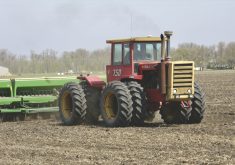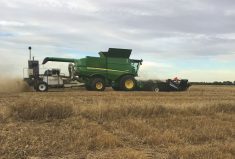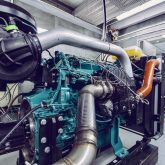A few years ago I was standing in a brand new ag equipment manufacturing plant in Germany listening to a senior brand executive talk about its cutting-edge design. Compared to the company’s old facility, he remarked, its storage area was relatively tiny. When asked why, his reply came quickly and with a smile: “We use the Autobahn for storage now.”
Just-in-time delivery had revolutionized manufacturing. All the inputs needed to build the implements his plant would assemble in the next couple of days were in trucks at that very minute, rolling somewhere across Europe’s highway system, each with a precisely scheduled delivery time that would keep the assembly line moving.
That just-in-time delivery concept has been widely adopted by industries in virtually all sectors of the economy in recent decades, and it made sense. Eliminating costly inventories and the need for the expensive facilities to house them reduces the cost of production. And, presumably, it helps keep purchase costs down for end-users — farmers in this case.
Read Also

What to consider when setting up farm-related business ventures
Things to consider before launching a farm-adjacent side business.
A finely balanced global shipping network kept those raw materials and component parts on the move. Suppliers anywhere on the globe who enjoyed a regional economic advantage could ship wherever needed in a relatively short time.
But then, along came COVID-19.
The pandemic threw a wrench into the system — or more accurately, multiple wrenches. Illnesses and lockdowns reduced output at many factories. Populations stuck at home turned to online shopping rather than spending their cash at restaurants and in other service sectors. That increased the demand for consumer goods, building increased demand for already struggling plants producing components such as semiconductors needed by automotive and ag equipment brands. It also overloaded transportation sectors, like trucking which was already struggling with its labour shortage, so now shipping container bottlenecks clog some U.S. ports with thousands of empties waiting weeks for a ride back to be refilled somewhere.
Over the course of 2021, those shortages forced temporary closures of many assembly plants in the automotive and equipment sectors, since they rely on a steady stream of components, which further reduced the level of production there just as demand for new equipment was on the rise.
In October CNH Industrial, parent company of Case IH and New Holland, announced in a press release, “it will temporarily close several of its European agricultural, commercial vehicle and powertrain manufacturing facilities in response to ongoing disruptions to the procurement environment and shortages of core components, especially semiconductors.”
In September, General Motors revealed it was about to shut down four U.S. plants as well as one in Canada and one in Mexico due to component shortages. Most other automotive brands have followed suit. As far back as April, Ford announced six pending plant closures, also due to component shortages, and estimated it would take a US$1.5 to US$2 billion hit to earnings by the end of 2021.
In December, the Association of Equipment Manufacturers (AEM) released the results of a survey of its members, which include most of the major ag equipment brands, detailing just how severe the problem has become: 95 per cent of them say they are still experiencing supply chain disruptions as severe as ever, both in North America and globally.
What’s more, 72 per cent think the problem is getting worse. More than half expect the disruptions to continue through 2022 and 14 per cent expect them to continue beyond that.
“Some of these issues could very well last until 2023, such as semiconductors and variable frequency drives, which basically every factory uses,” said AEM’s director of market intelligence Benjamin Duyck.
Of course, the law of supply and demand means with scarcity of supply comes increased prices. Adding to that, widespread increases in national inflation rates threaten to push up the cost of inputs as well as the price of finished machines made from them.
Over the past 12 months AEM members have reported increases in their implement sticker prices ranging from eight to 11 per cent. And replacement parts at dealership counters have jumped over 12 per cent, affecting even those who have opted to stand pat with their existing machinery fleets. Those increases far exceed the 5.25 per cent rise in the consumer price index in the U.S., where much of the major ag machinery that comes our way is built. (Canada’s CPI was only slightly lower, hitting 4.7 per cent in November.)
Making an already bad situation worse, 80 per cent of U.S. manufacturers reported having trouble staffing their job vacancies. Here, too, COVID-19 has had an influence. The rate of people leaving the workforce in 2020 was up significantly, for a variety of reasons according to numerous studies and largely affecting the generation known as the baby boomers.
On average two million boomers drop out of the U.S. labour market each year, but that number jumped to 3 million in the first year of the pandemic, according to EMSI, an international labour market data firm.
Boomers are now no longer the major birth cohort in the workforce, having been surpassed by millennials. And this may be a problem, the EMSI report shows, because millennials don’t bring the same attitude to work.
“By 2015, men ages 21 to 30 were working 12 per cent fewer weekly hours than they had been in in 2000, with one in eight not working at all the prior year,” reads the EMSI narrative.
In Canada, however, the participation rate for the core-age population (millennials) in November remained at a record 88.2 per cent for the third consecutive month, according Stats Canada. Within the core-aged population, the participation rates for both men (91.8 per cent) and women (84.6 per cent) also held steady.
Despite that, the Canadian Survey on Business Conditions for the third quarter of 2021, revealed 8.3 per cent of businesses expected to have more job vacancies over the next three months. Recruiting skilled employees was expected to be an obstacle for two in five (39.1 per cent) businesses in manufacturing, which had the highest proportion of all sectors.
In other words, many Canadian ag equipment companies face another challenge.
So much for the bad news. But it isn’t all bad.
“Net farm income in the U.S. is estimated to have increased by 19.6 per cent in 2020 and is forecasted to increase another 19.5 per cent in 2021 to U.S.$113 billion,” AEM’s Duyck reports. “Net farm income is at its highest level since 2013 and is 20 per cent above its 2020 average.”
Farmers with money in their pockets almost always translate into strong equipment sales numbers. And, of course, U.S. producers represent the major chunk of equipment buyers in North America for both U.S. and Canadian equipment companies.
In Canada, things look relatively good too, at least for the shor-term. The first three quarters of 2021 have already seen significant jumps in equipment sales numbers. But that wave may have crested. A crop production shortfall of just over 25 per cent due to prairie drought is likely to reduce net incomes and soften machinery demand by the end of 2022, according to Farm Credit Corp’s (FCC’s) forecast.
This could be offset by high commodity prices, though, so the drop in sales numbers may not be all that dramatic “Despite softer farm equipment sales, all equipment categories in 2022, except for combines, are projected to trend above their five-year average (2016-20),” says the FCC prediction.
So the challenge for brands is to keep assembly lines rolling at top speed to meet strong demand, while fighting hard to find and source a consistent supply of the components and layout needed to do that. Can corporate executives really show they deserve their big salaries?
















